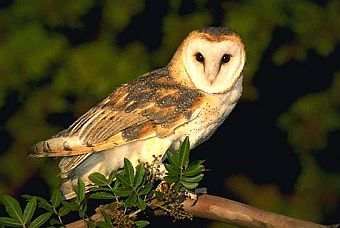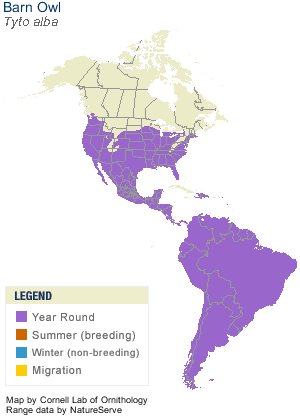
Description: 18" (46 cm). W. 3' 8" (1.1 m). Crow-sized. Buff-brown above and white below, with heart-shaped face and numerous fine dark dots on white underparts; dark eyes, long legs.
Habitat: Open country, forest edges and clearings, cultivated areas, and cities.
Nesting: 5-10 white eggs on bare wood or stone in buildings, hollow trees, caves, or even in burrows.
Range: Resident from southern British Columbia, Dakotas, Michigan, and southern New England southward. Also in South America and Old World.

Voice: Hissing notes, screams, guttural grunts, and bill snapping. Young give rapid grackle-like clicks.
Discussion: This nocturnal ghost of a bird frequents such places as belfries, deserted buildings, and hollow trees. It hunts its food -- almost entirely rodents -- in garbage dumps, neglected cemeteries, run-down farms, and empty lots in large cities. In the glare of auto headlights, a flying Barn Owl looks snow white and so is often mistaken for a Snowy Owl. Barn Owls are effective mousers and take many rats. Owls do not digest fur and bone but periodically rid themselves of these in the form of regurgitated pellets. Barn Owl pellets are easily collected from roosts and can be a useful source of information about the small mammals in an area. Contrary to popular belief, owls see well by day, but their large eyes do give them especially good night vision. Experiments have shown, however, that Barn Owls depend on keen hearing to locate their prey. These owls appear to practice birth control: When food is scarce they lay fewer eggs or may not breed at all.